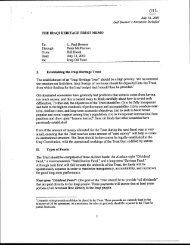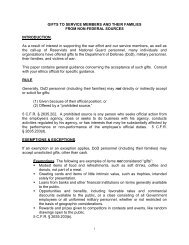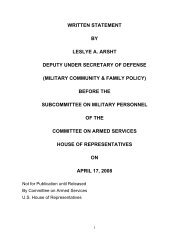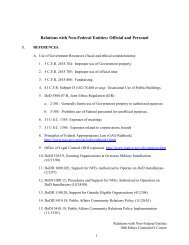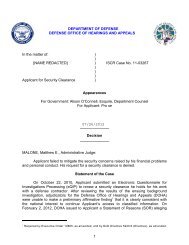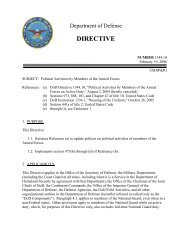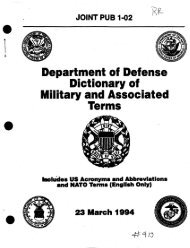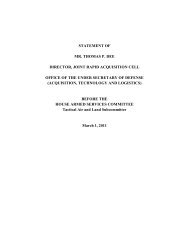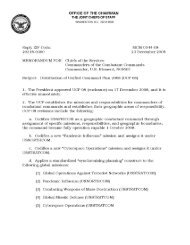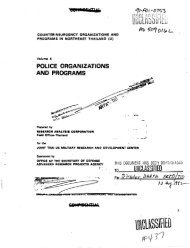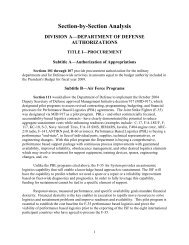dod tactical herbicide sites - United States Department of Defense
dod tactical herbicide sites - United States Department of Defense
dod tactical herbicide sites - United States Department of Defense
Create successful ePaper yourself
Turn your PDF publications into a flip-book with our unique Google optimized e-Paper software.
Aerospace Medical Division at Brooks Air Force Base, Texas provided pre- and postexposurephysical examinations to all active duty members <strong>of</strong> the CLSS units and otheractive duty military participating in PACER HO. The operation was completed at NCBCon 10 June 1977.Following the completion <strong>of</strong> Operation PACER HO at NCBC, military from theOccupational and Environmental Health Laboratory, Brooks Air Force, Texas supervisedthe initial clean up <strong>of</strong> the NCBC storage site including disposal <strong>of</strong> dunnage, contaminatedprotective clothing, and other waste materials. These were subsequently disposed <strong>of</strong> in anapproved landfill at the National Space and Technology Laboratory in Bay Saint Louis,Mississippi. The crushed 55-gallon drums were sold to a smelter. In August 1977, a soil,sediment, and biological monitor program was put into place to track the fate <strong>of</strong> TCDDand residues <strong>of</strong> Herbicide Orange in the NCBC environment. This monitoring programwas conducted by Active duty Air Force <strong>of</strong>ficers from the Occupational andEnvironmental Health Laboratory, San Antonio, TX and from the Engineering andServices Laboratory, Air Force Engineering and Services Center, Tyndall Air Force Base,Florida, conducted the monitoring program. In February 1989, the Air Force inaccordance with the <strong>Defense</strong> Environmental Restoration Program completed a final sitecleanup at NCBC by incinerating all remaining TCDD-contaminated soil.Sources: <strong>Department</strong> <strong>of</strong> the Air Force (1974): Final Environmental Statement on theDisposition <strong>of</strong> Orange Herbicide by Incineration. November 1974, <strong>Department</strong> <strong>of</strong> the AirForce, Washington, DC. Unclassified, available for public distribution.Young AL, Calcagni JA, Thalken CE, Tremblay JW (1978): The Toxicology,Environmental Fate, and Human Risk <strong>of</strong> Herbicide Orange and Its Associated Dioxin.Technical Report OEHL-TR-92, USAF Occupational and Environmental HealthLaboratory, Aerospace Medical Division, Brooks Air Force Base, Texas. Approved forpublic release, distribution unlimited.Miller RA, Shafts PA, Stieritz SF, Termena BJ (1980): The Disposal <strong>of</strong> HerbicideOrange, 1971-1979. Office <strong>of</strong> History, Air Force Logistics Command, Wright-PattersonAir Force Base, Ohio.Channel RE, Stoddart TL (1984): Herbicide Orange Monitoring Program. TechnicalReport ESL-TR-83-56, Engineering & Services Laboratory, Air Engineering & ServicesCenter, Tyndall AFB, Florida. Approved for public release, distribution unlimited.Cook JA, Haley DJ (1990): Full-scale Incineration Demonstration at the NavalConstruction Battalion Center, Gulfport, Mississippi. Final Report prepared by EG&GIdaho, Inc., Idaho Falls, Idaho, Technical Report ESL-TR-89-39, Engineering & ServicesLaboratory, Air Force Engineering & Services Center, Tyndall AFB, Florida. Approvedfor public release, distribution unlimited.73



